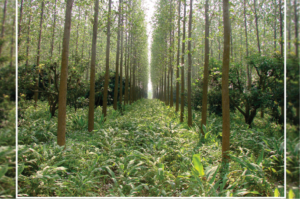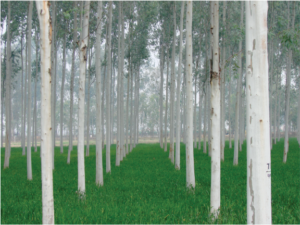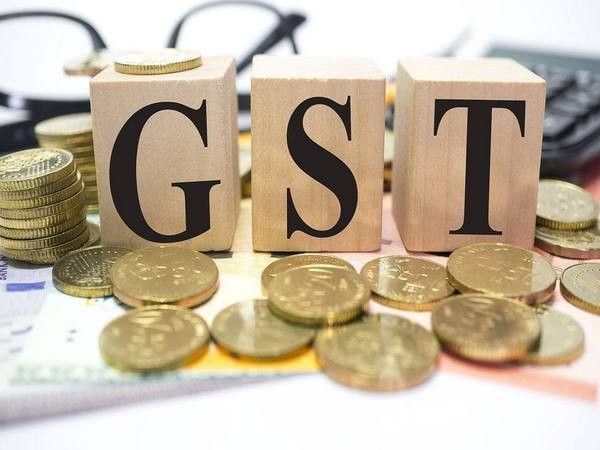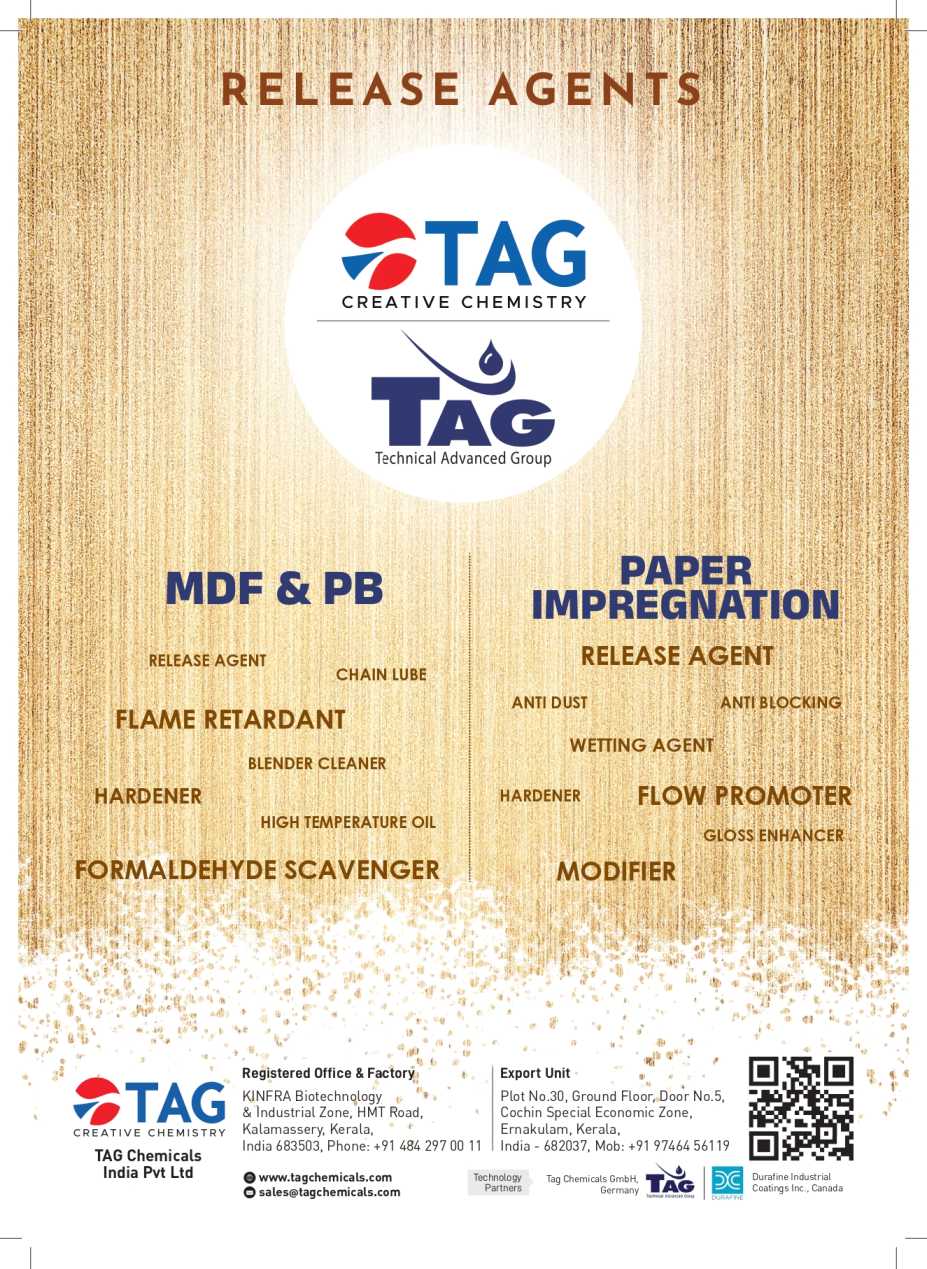
Diversification of Wheat-Paddy Cycle through Tree Farming
- सितम्बर 13, 2022
- 0
Recently, the Hon’ble Prime Minister of India chaired the National Conference of Chief Secretaries of the States and Union Territories in Himachal Pradesh wherein one of the agenda items was ‘Crop Diversification and Achieving Self-Sufficiency in Oilseeds, Pulses and Other Agri-Commodities’. This item focussed on the diversification of wheat-paddy cycle in Punjab, Haryana and Western Uttar Pradesh which produce surplus food grains but face hardships in their procurement and storage.
The continuous cultivation of paddy has also resulted in depletion of ground water table and soil nutrients which has led to reduction in the overall productivity of agricultural crops. The Government is promoting raising of alternate crops by improving their marketing and profitability, but it has not been very successful due to lack of adequate procurement and less profitability.
The farmers have already diversified wheat-paddy cycle in north India through farming of poplar and eucalyptus, as they are more profitable than agricultural crops. Once, I attended a workshop organised by the Indian Council of Agriculture Research (ICAR) in which the recommendations for diversification of agricultural crops did not include tree crops.
Hence, I, asked the Director General, ICAR who was chairing the session, as to why this option was not being promoted despite its success. He replied that being DG, ICAR, how he could recommend raising tree crops.
Presently, the import value of wood and wood products is about Rs 50,000 crore which is bound to increase in future, hence tree farming is a highly attractive option in the present scenario. Secondly, as the farm wood is produced in the farmlands, the biggest reform necessary from the legal angle is declaration of farm wood as an agricultural commodity and ext end all incentives and benefits of agricultural crops to tree crops.
Recently, the Haryana Government has extended ‘Mera Paani Meri Viraasat’ scheme to tree crops by bringing them at par with alternate crops like maize, bajra, cotton, etc. The cultivation of tree crops with agricultural crops also reduces the damage to them from heat waves like the one caused to standing wheat crop this year.

As per the ‘India State of Forest Report, 2021’, the trees outside forests (TOF) including agroforestry in Punjab, Uttar Pradesh and Haryana cover about 4.4%, 5.4% and 6.0% of their geographical areas, respectively. Due to our emphasis on conservation of forests, the production of large sized wood has reduced to about 03 million cum annually, and consequently about 06 million cum of timber is being imported annually.
For diversifying wheat-paddy cycle, it is proposed that the wood production may be doubled by bringing an additional area of 3-4% of the geographical areas of the above states, under agroforestry with focus on production of large sized wood by 2030. To achieve this ambitious target, the Government of India needs to make production of timber more lucrative (like expansion of highways presently) through incentivising the plantation companies by providing discounted loans, tax concessions, priority lending, etc. MoEFCC may design a scheme to encourage the farmers and absentee landlords to produce large sized wood.
The self-sufficiency in short-sized wood has been achieved mainly through improving the quality of plants, hence same strategy needs to be adopted for producing large-sized wood. To boost this sector, Government of India should revise its export/import policy to discourage import and encourage export of wood and wood products.
State Forest Departments (SFD) need to promote certification of farm woods to increase the export potential of wood products. SFDs may collaborate with institutions which may be able to sell the carbon credit of tree crops to industries for increasing the income of farmers. Recently, ITC Paper boards Ltd., tried to help small and marginal farmers in Odisha by arranging loans for their tree crops but most banks refused, while Bandhan Bank agreed to lend at 25% rate as compared to 4-5% rate provided through Kisan Credit Cards. The Government of India should deal with such type of discrimination.
The expansion of agroforestry would necessitate expansion of wood-based industries including their technological upgradation. As larger units are capable of developing partnerships with farmers in providing quality plants, extension services, marketing support, etc., they need to be invited by the states to make this sector competitive.
Generally, the State Level Committees established under the guidelines issued in 2016 by Ministry of Environment of Forests and Climate Change, do not accept the data relating to assessment of wood production from the ‘TOF’of the state due to the defective methodologies.On similar grounds, the decision to allow licenses to 1350 plywood units in Uttar Pradesh has also been held up in NGT/Apex Court since 2019. Hence, Forest Survey of India, Dehradun needs to develop appropriate assessment methodology, which will be used by the states to save valuable time.
Recently, Haryana Government organized a ‘Plywood Conclave’at Yamunanagar to develop it as an export hub of wooden panel products and announced a grant of Rs 50 crore for establishment of a research centre to promote plywood industry. The State Government has initiated the process of developing an inland container depot at Kalanaur (Yamunanagar) to facilitate the export of wood products. Similarly, other states need to initiate steps to develop new manufacturing hubs of wooden products.
Now-a-days several new Medium Density Fibreboard (MDF) units are coming up which will consume small sized wood leading in reduction of harvesting cycle of tree crops to 2-3 years. This will further enhance the adoption of tree crops by the farmers. The increased cultivation of tree crops in this region will lead to ‘Brown Revolution’, which will create additional employment opportunities in wood-based industries for youth who could not pursue their studies in schools/colleges. Besides diversification of agricultural crops, extensive cultivation of tree crops will increase carbon sequestration which will lead Haryana state on a path of carbon neutral economy.
वृक्षों की खेती के माध्यम से गेहूं-धान चक्र का विविधीकरण
हाल ही में, भारत के माननीय प्रधानमंत्री ने हिमाचल प्रदेश में राज्यों और केंद्र शासित प्रदेशों के मुख्य सचिवों के राष्ट्रीय सम्मेलन की अध्यक्षता की, जिसमें एजेंडा मदों में से एक ‘फसल विविधीकरण और तिलहन, दलहन और अन्य कृषि-वस्तुओं में आत्मनिर्भरता प्राप्त करना’ था। यह आइटम पंजाब, हरियाणा और पश्चिमी उत्तर प्रदेश में गेहूं-धान चक्र के विविधीकरण पर केंद्रित है, जो अधिशेष खाद्यान्न का उत्पादन करते हैं लेकिन उनकी खरीद और भंडारण में कठिनाइयों का सामना करते हैं।
धान की निरंतर खेती से भूजल स्तर और मिट्टी के पोषक तत्वों में भी कमी आई है जिससे कृषि फसलों की समग्र उत्पादकता में कमी आई है। सरकार वैकल्पिक फसलों के विपणन और लाभप्रदता में सुधार करके उन्हें बढ़ावा दे रही है, लेकिन यह बहुत सफल नहीं रही है। पर्याप्त खरीद और कम लाभ की कमी के कारण।
उत्तर भारत में किसानों ने पहले से ही पोपलर और सफेदा की खेती के माध्यम से गेहूं-धान चक्र में विविधता ला दी है, क्योंकि वे कृषि फसलों की तुलना में अधिक लाभदायक हैं। एक बार, मैंने भारतीय कृषि अनुसंधान परिषद (ICAR) द्वारा आयोजित एक कार्यशाला में भाग लिया, जिसमें कृषि फसलों के विविधीकरण की सिफारिशों में वृक्ष फसलों को शामिल नहीं किया गया था।
इसलिए, मैंने सत्र की अध्यक्षता कर रहे आईसीएआर के महानिदेशक से पूछा कि इस विकल्प की सफलता के बावजूद इस विकल्प को बढ़ावा क्यों नहीं दिया जा रहा है। उन्होंने जवाब दिया कि डीजी, आईसीएआर होने के नाते, वह पेड़ की फसल उगाने की सिफारिश कैसे कर सकते हैं।
वर्तमान में, लकड़ी और लकड़ी के उत्पादों का आयात मूल्य लगभग 50,000 करोड़ रुपये है जो भविष्य में बढ़ने के लिए बाध्य है, इसलिए वर्तमान परिदृश्य में वृक्षारोपण एक अत्यधिक आकर्षक विकल्प है। दूसरे, चूंकि खेत की लकड़ी का उत्पादन कृषि भूमि में किया जाता है, कानूनी दृष्टिकोण से आवश्यक सबसे बड़ा सुधार घोषणा है कृषि उत्पादों के रूप में कृषि योग्य लकड़ी और कृषि फसलों के सभी प्रोत्साहनों और लाभों को पेड़ की फसलों तक पहुंचाएं।
हाल ही में, हरियाणा सरकार ने मक्का, बाजरा, कपास, आदि जैसी वैकल्पिक फसलों के बराबर लाकर पेड़ की फसलों के लिए ‘मेरा पानी मेरी विरासत’ योजना का विस्तार किया है। कृषि फसलों के साथ पेड़ की फसलें भी उन्हें गर्मी की लहरों से होने वाले नुकसान को कम करती हैं जैसे कि इस साल गेहूं की फसल को हुआ।
’इंडिया स्टेट ऑफ फॉरेस्ट रिपोर्ट, 2021’ के अनुसार, पंजाब, उत्तर प्रदेश और हरियाणा में कृषि वानिकी सहित वनों के बाहर के पेड़ क्रमशः अपने भौगोलिक क्षेत्रों के लगभग 4.4 प्रतिशत, 5.4 प्रतिशत और 6.0 प्रतिशत को कवर करते हैं। हमारे जोर के कारण वनों के संरक्षण पर, बड़े आकार की लकड़ी का उत्पादन घटकर लगभग 03 मिलियन घन मीटर सालाना हो गया है, और परिणामस्वरूप सालाना लगभग 06 मिलियन घन मीटर लकड़ी का आयात किया जा रहा है।
गेहूं-धान चक्र में विविधता लाने के लिए, यह प्रस्तावित है कि 2030 तक बड़े आकार की लकड़ी के उत्पादन पर ध्यान केंद्रित करते हुए, उपरोक्त राज्यों के भौगोलिक क्षेत्रों के 3-4 प्रतिशत अतिरिक्त क्षेत्र को कृषि वानिकी के तहत लाकर लकड़ी का उत्पादन दोगुना किया जा सकता है। इसे प्राप्त करने के लिए महत्वाकांक्षी लक्ष्य, भारत सरकार को रियायती ऋण, कर रियायतें, प्राथमिकता ऋण आदि प्रदान करके वृक्षारोपण कंपनियों को प्रोत्साहित करके लकड़ी के उत्पादन को अधिक आकर्षक (जैसे वर्तमान में राजमार्गों का विस्तार) बनाने की आवश्यकता है। MoEFCC किसानों और अनुपस्थित जमींदार को प्रोत्साहित करने के लिए एक योजना तैयार कर सकता है जो बड़े आकार की लकड़ी का उत्पादन करें।
छोटे आकार की लकड़ी में आत्मनिर्भरता मुख्य रूप से पौधों की गुणवत्ता में सुधार के माध्यम से हासिल की गई है, इसलिए बड़े आकार की लकड़ी के उत्पादन के लिए एक ही रणनीति अपनाई जानी चाहिए। इस क्षेत्र को बढ़ावा देने के लिए, भारत सरकार को आयात को हतोत्साहित करने और लकड़ी और लकड़ी के उत्पादों के निर्यात को प्रोत्साहित करने के लिए अपनी निर्यात/आयात नीति को संशोधित करना चाहिए।

राज्य वन विभागों (एसएफडी) को लकड़ी के उत्पादों की निर्यात क्षमता बढ़ाने के लिए कृषि लकड़ी के प्रमाणीकरण को बढ़ावा देने की आवश्यकता है। एसएफडी उन संस्थानों के साथ सहयोग कर सकते हैं जो किसानों की आय बढ़ाने के लिए पेड़ों की फसलों के कार्बन क्रेडिट को उद्योगों को बेचने में सक्षम हो सकते हैं। हाल ही में, ITC पेपरबोर्ड्स लिमिटेड ने ओडिशा में छोटे और सीमांत किसानों को उनकी पेड़ फसलों के लिए ऋण की व्यवस्था करके मदद करने की कोशिश की, लेकिन अधिकांश बैंकों ने मना कर दिया, जबकि बंधन बैंक किसान क्रेडिट के माध्यम से प्रदान की गई 4-5 प्रतिशत की दर की तुलना में 25 प्रतिशत की दर से उधार देने के लिए सहमत हुआ। भारत सरकार को इस तरह के भेदभाव से निपटना चाहिए।
कृषि वानिकी के विस्तार के लिए लकड़ी आधारित उद्योगों के विस्तार की आवश्यकता होगी जिसमें उनका तकनीकी उन्नयन भी शामिल है। चूंकि बड़ी इकाइयां गुणवत्ता वाले पौधे, विस्तार सेवाएं, विपणन सहायता आदि प्रदान करने में किसानों के साथ साझेदारी विकसित करने में सक्षम हैं, इसलिए इस क्षेत्र को प्रतिस्पर्धी बनाने के लिए राज्यों द्वारा उन्हें आमंत्रित करने की आवश्यकता है।
सामान्यतः वन एवं जलवायु परिवर्तन मंत्रालय द्वारा वर्ष 2016 में जारी दिशा-निर्देशों के तहत स्थापित राज्य स्तरीय समितियां दोषपूर्ण कार्यप्रणाली के कारण राज्य के ‘टीओएफ’ से लकड़ी उत्पादन के आकलन से संबंधित आंकड़ों को स्वीकार नहीं करती हैं। इसी आधार पर उत्तर प्रदेश में 1350 प्लाईवुड इकाइयों को लाइसेंस की अनुमति देने के लिए 2019 से एनजीटी/शीर्ष न्यायालय निर्णय में भी रोक लगाई गई है। इसलिए, भारतीय वन सर्वेक्षण, देहरादून को उचित मूल्यांकन पद्धति को अपनाने की आवश्यकता है। जिसका उपयोग राज्यों द्वारा मूल्यवान समय बचाने के लिए किया जाएगा।
हाल ही में, हरियाणा सरकार ने यमुनानगर में लकड़ी के पैनल उत्पादों के निर्यात केंद्र के रूप में विकसित करने के लिए एक ‘प्लाईवुड कॉन्क्लेव’ का आयोजन किया और प्लाईवुड उद्योग को बढ़ावा देने के लिए एक शोध केंद्र की स्थापना के लिए 50 करोड़ रुपये के अनुदान की घोषणा की। राज्य सरकार ने लकड़ी उत्पादों के निर्यात की सुविधा के लिए कलानौर (यमुनानगर) में एक अंतर्देशीय कंटेनर डिपो विकसित करने की प्रक्रिया शुरू की है। इसी तरह, अन्य राज्यों को लकड़ी के उत्पादों के नए विनिर्माण केंद्रों को विकसित करने के लिए कदम उठाने की जरूरत है।
आजकल कई नई मध्यम घनत्व फाइबरबोर्ड (एमडीएफ) इकाइयां आ रही हैं जो पेड़ की फसलों के कटाई चक्र को 2-3 साल तक कम करते हुए छोटे आकार की लकड़ी की खपत करेगी। इससे किसानों द्वारा वृक्ष फसलों को अपनाने में और वृद्धि होगी। इस क्षेत्र में वृक्ष फसलों की बढ़ी हुई खेती से ‘भूरी क्रांति’ आएगी, जिससे उन युवाओं के लिए लकड़ी आधारित उद्योगों में अतिरिक्त रोजगार के अवसर पैदा होंगे जो स्कूल/कॉलेजों में अपनी पढ़ाई नहीं कर सके। कृषि फसलों के विविधीकरण के अलावा, वृक्ष फसलों की व्यापक खेती से कार्बन सीक्वेस्ट्रेशन बढ़ेगा जो हरियाणा राज्य को कार्बन न्यूट्रल अर्थव्यवस्था के पथ पर ले जाएगा।
लेखक सेवानिवृत्त आईएफएस अधिकारी और पूर्व एमडी हरियाणा वन विकास निगम हैं।

































































